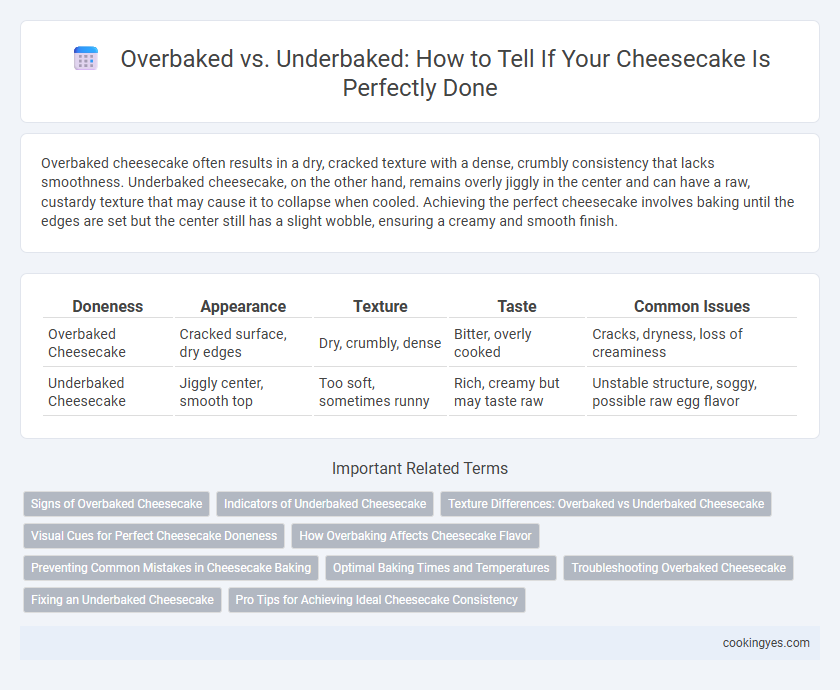Overbaked cheesecake often results in a dry, cracked texture with a dense, crumbly consistency that lacks smoothness. Underbaked cheesecake, on the other hand, remains overly jiggly in the center and can have a raw, custardy texture that may cause it to collapse when cooled. Achieving the perfect cheesecake involves baking until the edges are set but the center still has a slight wobble, ensuring a creamy and smooth finish.
Table of Comparison
| Doneness | Appearance | Texture | Taste | Common Issues |
|---|---|---|---|---|
| Overbaked Cheesecake | Cracked surface, dry edges | Dry, crumbly, dense | Bitter, overly cooked | Cracks, dryness, loss of creaminess |
| Underbaked Cheesecake | Jiggly center, smooth top | Too soft, sometimes runny | Rich, creamy but may taste raw | Unstable structure, soggy, possible raw egg flavor |
Signs of Overbaked Cheesecake
Signs of overbaked cheesecake include a cracked or dry surface, an excessively browned top, and a crumbly texture that lacks creaminess. The edges may pull away from the pan, and the cheesecake often feels dense rather than smooth and silky. Overbaking also results in a less flavorful dessert with a tougher consistency compared to the ideal moist, tender texture.
Indicators of Underbaked Cheesecake
Indicators of underbaked cheesecake include a wet or jiggly center that does not set when gently shaken, a texture that is overly creamy or runny, and edges that appear firm while the middle remains noticeably soft. The cheesecake may also sink in the middle as it cools, signaling insufficient baking time. Proper doneness is achieved when the center slightly jiggles but is not liquid, ensuring a smooth yet stable consistency.
Texture Differences: Overbaked vs Underbaked Cheesecake
Overbaked cheesecake develops a dry, crumbly texture with cracks on the surface due to excessive heat causing protein over-coagulation. Underbaked cheesecake remains overly soft and jiggly in the center, lacking the dense, creamy consistency typical of ideal doneness. Achieving perfect texture balance requires precise baking time and temperature control to preserve moisture while fully setting the custard.
Visual Cues for Perfect Cheesecake Doneness
A perfectly baked cheesecake exhibits a slightly golden edge with a creamy, jiggly center that gently settles as it cools. Overbaked cheesecakes often develop cracks on the surface and turn a dull, matte color, signaling dryness. Underbaked cheesecakes appear overly wet and glossy in the middle, lacking the characteristic firmness needed for optimal texture.
How Overbaking Affects Cheesecake Flavor
Overbaking cheesecake causes the texture to become dry and crumbly, negatively impacting the creamy mouthfeel that defines a well-made cheesecake. Excessive heat also caramelizes the sugars in the batter, resulting in a bitter taste that masks the delicate cream cheese flavor. Precise timing and temperature control are crucial to preserving the balanced sweetness and smooth richness essential for an ideal cheesecake experience.
Preventing Common Mistakes in Cheesecake Baking
Overbaking cheesecake causes a dry, cracked texture while underbaking leads to a runny center that fails to set properly. Maintaining oven temperature around 325degF and baking until the edges are set but the center slightly jiggly prevents these common issues. Using a water bath helps regulate heat evenly, reducing risks of over- or underbaking for a smooth, creamy cheesecake.
Optimal Baking Times and Temperatures
Optimal baking times and temperatures for cheesecake typically range between 325degF to 350degF for 45 to 60 minutes, ensuring a creamy texture with slight jiggle in the center. Overbaked cheesecake has a dry, cracked surface and dense texture due to excessive heat or prolonged baking. Underbaked cheesecake appears wet or custardy and lacks structure, which can be avoided by carefully monitoring the internal temperature, ideally around 150degF to 155degF.
Troubleshooting Overbaked Cheesecake
Overbaked cheesecake often has a dry, crumbly texture and may develop cracks on the surface due to excessive heat causing the proteins to tighten. To troubleshoot, reduce oven temperature by 10-25degF and bake until the edges are set but the center slightly jiggles, ensuring a smooth, creamy consistency. Using a water bath helps maintain even baking temperature and prevents overbaking, preserving moisture in the cheesecake.
Fixing an Underbaked Cheesecake
An underbaked cheesecake often appears jiggly in the center and may not set properly, requiring additional baking time to achieve the ideal creamy texture. To fix an underbaked cheesecake, return it to the oven at a low temperature (around 325degF or 160degC) and bake until the center is just set but still slightly jiggles when shaken gently. Avoid overbaking by monitoring closely to prevent cracks and dry texture while ensuring the cheesecake maintains its rich, smooth consistency.
Pro Tips for Achieving Ideal Cheesecake Consistency
Achieving the perfect cheesecake involves avoiding common mistakes like overbaking, which leads to a dry, crumbly texture, and underbaking, resulting in a soggy center that lacks structure. Pro tips emphasize baking at a low temperature, using a water bath to maintain even heat, and checking for a slight jiggle in the center to ensure creamy consistency without cracks. Resting the cheesecake in the refrigerator for several hours enhances firmness and flavor balance, delivering the ideal smooth and luscious dessert texture.
Overbaked vs underbaked for cheesecake doneness Infographic

 cookingyes.com
cookingyes.com